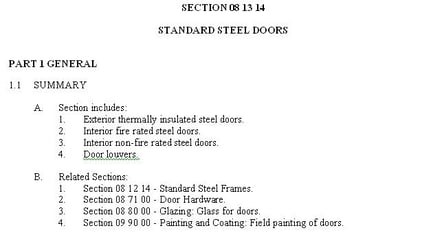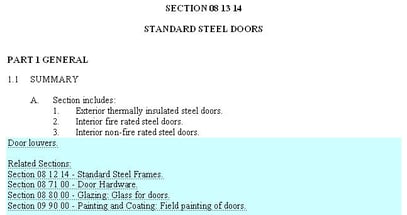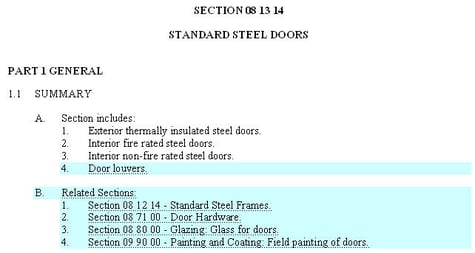What documents are architects obligated to produce? The obvious answer may be drawings, of course, to show what design must be constructed. Under AIA Owner-Architect Agreement documents, in addition to drawings, the architect must produce outline specifications during Design Development (DD) phase and construction specifications during Construction Documents (CD) phase.
Drawings
When drawings were produced by hand, Schematic Design (SD) drawings were usually replaced when Design Development (DD) phase documents were started. The SD drawings were graphic, conceptual representations of the design. Because of their nature, the SD drawings were rarely suitable for use once SD phase was completed. The scene changed in the 1970s when commercial CAD software made its debut.
Today, drawings are produced electronically, whether as CAD or BIM files, the initial design files may be transformed into later design documents. The electronic files are significantly more easily modified, updating and refining the graphics during each design phase. There is no need to discard early design drawings to progress to the next level of development.
Many drawings for each project are unique to the project. They are specially developed to suit the particular project - plans, elevations, sections - all unique. There will be some standardized details incorporated into the overall project set, but these will be the minority. Each unique drawing is initiated and further developed during the design process.
Construction Specifications
Not all that long ago, specifications were actually typed - yes on a typewriter, a manual typewriter most likely. Specifications entered the electronic age, also, in the 1970s when standalone word processors became available. By the late 1970s SpecText, the first commercial master guide specification system, was offered on a remote mainframe computer, editable via "dumb" terminals.
Today, specifications are produced on personal computers using a variety of word processing and database software programs. Master guide construction specifications files are written to be "all-inclusive" allowing specifiers to primarily delete what is not required for a particular project.
Outline Specifications
To produce DD phase outline specifications efficiently, specifiers created a separate set of files as outline specs. Outline specs follow the corresponding construction specifications, but are significantly, selectively, reduced. The documents are pared down to reflect principal products and requirements affecting quality and cost.
Maintaining a separate set of files as outline specifications is a concept promoted by the Construction Specifications Institute in the Specifying Practice Guide to reduce the time required to produce a set of project outline specs.
Multipurpose Documents
Design and design drawings are iterative. Electronic drawings are developed as the design progresses. Data and detail are added to the current drawings during each design phase to document the progress. Early design drawings are developed and transformed into final construction documents as a result of the design process.
Specifications, typically, have a different fate. Word processing DD outline specifications cannot be transformed into construction documents, easily. Outline specifications serve as reference data for developing construction specifications. During the CD phase specifiers must recreate the same decisions made to create the outline specifications. Unfortunately, the exercise of recreating previous edits requires time and invites potential error.
Database specification programs such as Speclink have partially solved the problem of making specifications multipurpose documents. Speclink offers a global switch to view and print specifications in outline, short, or full length forms. However, the content of each view is not entirely under the specifier's control. Paragraphs assigned to outline or short form view in the master database by the software developers cannot be assigned to a different view. The specifier is able to assign full length master paragraphs and new user paragraphs to either the outline or short form views.
Another Approach
Conspectus has developed a method using standard word processing tools. Master guide specifications can be used to create outline specifications and then expanded quickly to create construction specifications. No separate set of files is required. Maximum flexibility is available to include what ever text is appropriate for the outline spec. Plus the specifier is in complete control of the outcome.

The tools hide text and remove the paragraph numbering for paragraphs not required for outline specs. The hidden text is not visible when viewed on screen and when printed. The visible paragraph numbers remain consecutive, despite the hidden text. The hidden text remains part of the file for future editing when the specifier begins writing the construction documents. None of the outline editing decisions must be recreated.
 Construction specifications can be quickly, automatically, reduced to an outline form. The reduction is completely controllable and adjustable. All text can be included or hidden at the specifier's discretion. Then the visible text is edited to suit the particular project.
Construction specifications can be quickly, automatically, reduced to an outline form. The reduction is completely controllable and adjustable. All text can be included or hidden at the specifier's discretion. Then the visible text is edited to suit the particular project.
When starting the construction specifications, the hidden text is restored. The restored text is color coded so specifiers know what text was not edited to create the outline spec. After editing the color coding is removed and the spec is ready to issue for construction.

